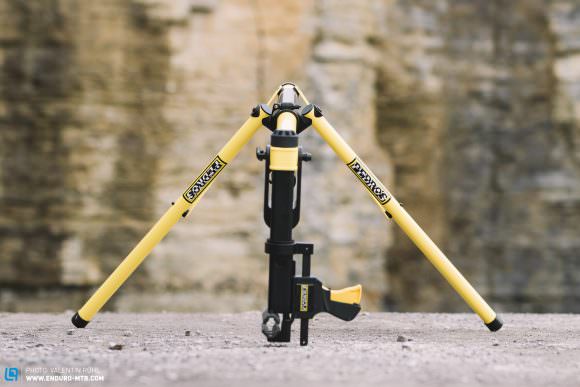Whether you want to take off your wheels and change tires, adjust the gears, lubricate a dried-up chain, replace worn-out brake pads or remove your fork and shock for an annual service, there are plenty of good reasons to own a bike repair-stand. We tested eight popular models in a price range between € 130 and € 440 and can tell you which one is the best choice for your mobile-workshop.
What should you consider when choosing a repair-stand?
The answer is easy. It’s got to be stable, reliable and durable. In this test we focused mainly on portable models. Robustness is crucial but not the only important factor and there are lots of other aspects to consider. For example lightweight tubing, arms and legs are essential for easy transportation and trouble-free handling. A mobile repair stand also needs to be robust in order to withstand intensive use and survive frequent assembly/disassembly. The procedure has to be quick and straightforward and the folded stand should be as compact as possible once packed up. The less space it takes when collapsed, the better – whether in the car, in your flat or basement.

Easy handling is one of the most important factors. The head and its clamping system have to be intuitive, simple to use and only require the use of one hand. Nobody wants to hold up their bike for ten minutes while sorting out the clamp with the other hand.
Even the most practical and comfortable head-clamps would be totally useless in combination with a stand that isn’t stable on all surfaces. There are some major differences between systems but still criteria such as the length of the legs, the angle and stiffness of the tubing and the connections are essential requirements for any type of stand. Ideally all connections should be bolted together to allow for tightening and the individual parts should be replaceable if necessary.

We wanted to understand whether more money necessarily means better performance and that’s why we set a test-field with a broad price range (€ 130 to € 440). That’s why Park Tool and Feedback Sports are included in our test with two products each – respectively one top model and another one that costs almost half as much.
The winner of this test can be proud of being a universal talent. It’s as light and compact as it gets and yet sturdy, stable, comfortable and intuitive in all sorts of scenarios – for a reasonable price.
Three legged vs two legged
Generally there aren’t any significant advantages to one or the other system; both have their pros and cons. As a rule of thumb two-legged work stands offer a little more stability under load, more room for pedal movement and usually have a smaller footprint. On the other hand they are far less stable without load and are not the ideal solution on uneven or sloping surfaces; In this case three legged stands are a much better option. Thanks to a central column these adapt much better to the surface they’re standing on and allow the bike to swivel by 360 degrees. The only weak point of three legged models is the connection between the legs and the central column; this isn’t stable enough, it can cause the stand to bend under heavy loads and in some cases it can restrict the space between the pedals and the central column. We would generally recommend a two legged stand for home-workshop applications and a three-legged model for “on the go” scenarios and uneven surfaces.


The repair stands in our test
| Brand | Model | Price | Weight | Additional |
|---|---|---|---|---|
| Contec | Rocky Steady | € 129.95 | 4.56 kg | – |
| Unior | 1693A BikeGator+ | € 328.00 | 6.56 kg | includes a tray |
| Pedros | Folding Repair Stand | € 385.00 | 9.30 kg | includes a bag |
| Feedback Sports | Sport Mechanic | € 169.90 | 5.72 kg | – |
| Feedback Sports | Pro Elite | € 299.95 | 5.50 kg | – |
| Topeak | Prep Stand Pro* | € 329.95 | 6.56 kg | includes a bag |
| Park Tool | PRS-25 | € 439.99 | 5.96 kg | – |
| Park Tool | PCS-10 | € 249.99 | 7.70 kg | – |
*The Prep Stand Elite for € 279.95 (the exact same model only without the integrated scale) wasn’t available at the time of our test.









